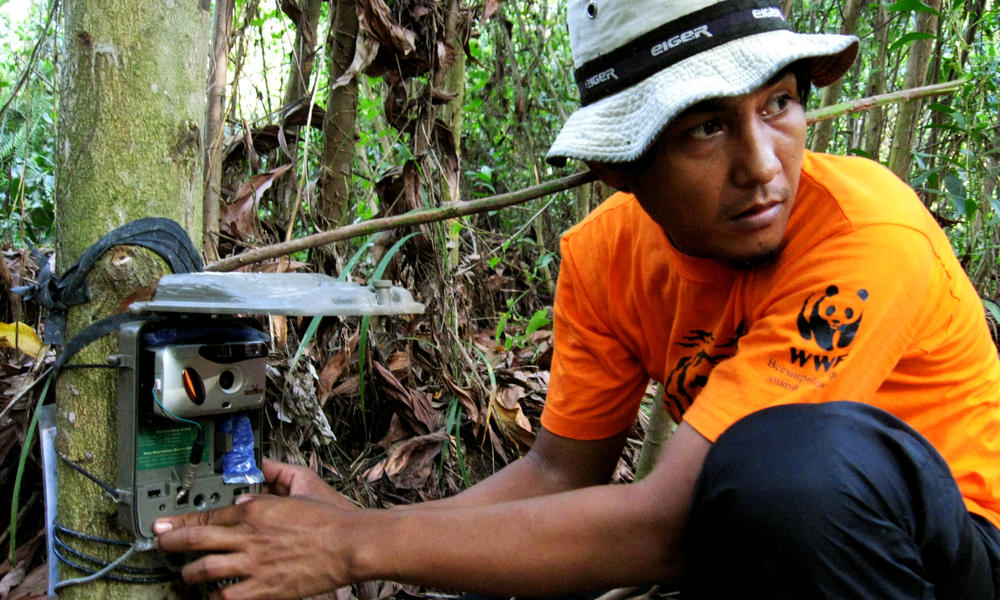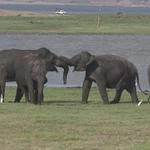Tiger
Facts
After a century of decline, overall wild tiger numbers are starting to tick upward. Based on the best available information, tiger populations are stable or increasing in India, Nepal, Bhutan, Russia and China. An estimated 3,900 tigers remain in the wild, but much more work is needed to protect this species if we are to secure its future in the wild. In some areas, including much of Southeast Asia, tigers are still in crisis and declining in number.
-
EN
Status
Endangered
-
Population
Around 3,900
-
Scientific Name
Panthera tigris
-
Weight
220–660 pounds
-
Length
6–10 feet
-
Habitats
Tropical rainforests, evergreen forests, temperate forests, mangrove swamps, grasslands, and savannas
Map data provided by IUCN
There are two recognized subspecies of tiger*: the continental (Panthera tigris tigris) and the Sunda (Panthera tigris sondaica). The largest of all the Asian big cats, tigers rely primarily on sight and sound rather than smell for hunting. They typically hunt alone and stalk prey. A tiger can consume more than 80 pounds of meat at one time. On average, tigers give birth to two to four cubs every two years. If all the cubs in one litter die, a second litter may be produced within five months.
Tigers generally gain independence at around two years of age and attain sexual maturity at age three or four for females and four or five years for males. Juvenile mortality is high, however—about half of all cubs do not survive more than two years. Tigers have been known to reach up to 20 years of age in the wild.
Males of the larger subspecies, the continental tiger, may weigh up to 660 pounds. For males of the smaller subspecies—the Sunda tiger—the upper range is at around 310 pounds. Within both subspecies, males are heavier than females.
Tigers are mostly solitary, apart from associations between mother and offspring. Individual tigers have a large territory, and the size is determined mostly by the availability of prey. Individuals mark their domain with urine, feces, rakes, scrapes, and vocalizing.
Across their range, tigers face unrelenting pressures from poaching, retaliatory killings, and habitat loss. They are forced to compete for space with dense and often growing human populations.
*New Subspecies Classifications
Since 2017, IUCN has recognized two tiger subspecies, commonly referred to as the continental tiger and the Sunda island tiger. All remaining island tigers are found only in Sumatra, with tigers in Java and Bali now extinct. These are popularly known as Sumatran tigers. The continental tigers currently include the Bengal, Malayan, Indochinese and Amur (Siberian) tiger populations, while the Caspian tiger is extinct in the wild. The South China tiger is believed to be functionally extinct.
- Habitats
Patrol ranger Qiu Shi on protecting China’s tigers

The Tiger Family
Why They Matter
Threats
- Population Around 3,900
-
Extinction Risk Endangered
-
EX
Extinct
No reasonable doubt that the last individual has died
-
EW
Extinct in the Wild
Known only to survive in cultivation, in captivity or as a naturalised population
-
CR
Critically Endangered
Facing an extremely high risk of extinction in the Wild
-
EN
Endangered
Facing a high risk of extinction in the Wild
-
VU
Vulnerable
Facing a high risk of extinction in the Wild
-
NT
Near Threatened
Likely to qualify for a threatened category in the near future
-
LC
Least Concern
Does not qualify for Critically Endangered, Endangered, Vulnerable, or Near Threatened
-
EX
Poaching and illegal wildlife trade
Poaching is the most immediate threat to wild tigers. Every part of the tiger—from whisker to tail—has been found in illegal wildlife markets. A result of persistent demand, their bones, and other body parts are used for modern health tonics and folk remedies, and their skins are sought after as status symbols among some Asian cultures.
There are often limited resources for guarding protected areas in the countries where tigers live. Even countries with strong enforcement of tiger protection laws continue to fight a never-ending battle against poaching, which is now often orchestrated by transnational crime syndicates that rake in significant profits from wildlife crime and undermine the security of local communities.
The impact from the death of a single tiger at the hands of poachers reaches beyond one single loss. If a female tiger with cubs is killed, her cubs will most likely die without their mother, and the female's potential for future breeding is lost. If a male is killed, his death can result in intense competition for his territory among surviving males in the population, leading to potential injury and death.
Habitat loss
Tigers have lost an estimated 95% of their historical range. Their habitat has been destroyed, degraded, and fragmented by human activities. The clearing of forests for agriculture and timber, as well as the building of road networks and other development activities, pose serious threats to tiger habitats. Tigers need wide swaths of habitat for their survival since they have large home ranges and are very territorial. Fewer tigers can survive in small, scattered islands of habitat, which leads to a higher risk of inbreeding and makes tigers more vulnerable to poaching as they venture beyond protected areas to establish their territories. This underscores the need to ensure habitat connectivity between the protected areas where tigers live.
Human-Wildlife Conflict
People and tigers increasingly compete for space. As forests shrink and prey becomes scarce, tigers are forced to leave protected areas in search of food and to establish territories. This takes them into human-dominated areas that lie between habitat fragments, where they can hunt domestic livestock that many local communities depend on for their livelihood. In retaliation, tigers are sometimes killed or captured. “Conflict” tigers can end up for sale in black markets. Local community dependence on forests for fuel wood, food, and timber heightens the risk of tiger attacks on people.
Effects of Climate Change

One of the world’s largest, and most uniquely-adapted, tiger populations are found in the Sundarbans—a large mangrove forest area shared by India and Bangladesh on the coast of the Indian Ocean. It is also the only coastal mangrove tiger habitat in the world. These mangrove forests harbor a variety of species, including tigers, and protect coastal regions from storm surges and wind damage. However, rising sea levels caused by climate change threaten to wipe out these forests and the last remaining habitat of this tiger population. According to a WWF study, without mitigation efforts, projected sea-level rise—about a foot by 2070—could destroy nearly the entire Sundarbans tiger habitat.
Tiger "Farms" and Captive Tigers
Current estimates indicate that there are more than 8,000 tigers being held in more than 200 centers in East and Southeast Asia, with roughly three-quarters of these tigers located in China. The current scale of commercial captive breeding efforts within these farms is a significant obstacle to the recovery and protection of wild tiger populations because they perpetuate the demand for tiger products, serve as a cover for illegal trade and undermine enforcement efforts. WWF is engaging with governments in countries with active tiger farms, and advocates ending breeding and phasing out the farms. WWF also advocates for improved regulation of the captive tiger population in the US. It is estimated that approximately 5,000 tigers reside in the US, and we must ensure that these animals are not exploited by, or contributing to, the illegal trade in tigers and their parts.
What WWF Is Doing

As demonstrated in a number of areas, wild tigers can recover. In 2010, the 13 tiger range countries committed to TX2—doubling wild tiger numbers by 2022, the next Year of the Tiger. In pursuing TX2, WWF and its partners have taken a comprehensive approach to tiger conservation.
Protecting Tigers
WWF works to enforce zero tolerance for tiger poaching across Asia. We help build the capacity of government enforcement units in each landscape and install the best new technologies to assist local agencies by achieving conservation results. We help improve the effectiveness of wildlife rangers by training personnel from enforcement agencies on tools such as SMART (Spatial Monitoring and Reporting Tool). We also work to ensure that communities have a stake in conservation, as they are typically the best stewards and managers of their natural resources.
Preserving and Connecting Tiger Habitat
Tigers need secure areas to thrive, and our work to protect and connect their fragile habitat is based on rigorous scientific analysis. WWF has chosen places to focus its resources based on the best available science and where tigers have the best chance of recovery and long-term persistence. The locations encompass tiger corridors that link tiger sites within landscapes. Our work includes building local capacity to manage protected areas, coordinating with partners to manage core tiger areas and corridors, and addressing human-wildlife conflict and the impacts of infrastructure development in tiger landscapes. To ensure effective conservation management of tiger sites, the Conservation Assured Tiger Standards (CA|TS) provide a minimum set of standards to encourage the long-term success of tiger conservation and best practices in these areas. Nine of the 13 tiger range countries are currently implementing CA|TS or in discussions on registering, and two sites have achieved CA|TS approval by meeting all the required standards.
Monitoring Tigers and Their Prey

Monitoring tigers and their prey is essential to achieving our goal of doubling wild tiger populations. By employing camera traps, tracking technologies and DNA collected from scat (droppings), we analyze the progress of tiger populations in order to adapt our strategies and make conservation decisions based on strong science and field experience.
Building Political Will
WWF works with governments across the 13 tiger range countries with wild tiger populations to build and maintain momentum around the conservation of tigers, which is an asset that can enhance their development agendas. By linking tiger conservation with forest preservation and carbon sequestration efforts, tiger range nations and their partners can demonstrate their commitment to promoting a healthy environmental and economic future.
Eliminating Tiger Trade
Trade in tiger parts and products is a major threat to wild tiger survival. Together with TRAFFIC, the global wildlife trade monitoring network, we implement strategies to help governments stop wildlife criminal networks, shut down black markets and change consumer behavior. We conduct investigations to document the tiger trade, catalyze action against it and help train enforcement agencies. We continue to build strategies to reduce demand for tiger parts and products and shut down tiger “farms”.
Press Releases
Projects
-
Transforming the global rubber market
Forests in Asia, home to elephants, tigers and other endangered species—are often cleared to make room for growing rubber trees. They are among the most threatened forests in the world. That’s why WWF has set an ambitious goal of transforming the global rubber market.
-
Shutting Down Tiger Farms
Tiger ‘farms’ are captive facilities that breed tigers to supply or directly engage in the commercial trade of tiger parts or products. WWF is calling for greater oversight and protection of all captive tigers.
Publications
-

Falling through the system: The role of the European captive tiger population in the trade of tigers
-
Skin and Bones Unresolved: An analysis of tiger seizures from 2000-2018
-

Beyond the stripes: Save tigers, save so much more
-
Global Tiger Status
Experts
Related Species
-
 Jaguar
Jaguar
-
 Snow Leopard
Snow Leopard
-
 Amur Leopard
Amur Leopard
-
 Chimpanzee
Chimpanzee
-
 Giant Panda
Giant Panda
-
 Macaw
Macaw
-
 Poison Dart Frog
Poison Dart Frog
-
 Saola
Saola
-
 Orangutan
Orangutan
-
 African Wild Dog
African Wild Dog
-
 Cross River Gorilla
Cross River Gorilla
-
 Mountain Gorilla
Mountain Gorilla
-
 Monarch Butterfly
Monarch Butterfly
-
 Red Panda
Red Panda
-
 African Elephant
African Elephant
-
 Sunda Tiger
Sunda Tiger
-
 Sumatran Rhino
Sumatran Rhino
-
 Brown Bear
Brown Bear
-
 Forest Elephant
Forest Elephant
-
 Western Lowland Gorilla
Western Lowland Gorilla
-
 Gorilla
Gorilla
-
 Eastern Lowland Gorilla
Eastern Lowland Gorilla
-
Bonobo
-
 Bornean Orangutan
Bornean Orangutan
-
 Black Spider Monkey
Black Spider Monkey
-
 Tree Kangaroo
Tree Kangaroo
-
 Asian Elephant
Asian Elephant
-
 Javan Rhino
Javan Rhino
-
 Greater One-Horned Rhino
Greater One-Horned Rhino
-
 Bornean Elephant
Bornean Elephant
-
 Sri Lankan Elephant
Sri Lankan Elephant
-
 Sumatran Elephant
Sumatran Elephant
-
Sloth
-
 Continental Tiger
Continental Tiger
 Nilanga Jayasinghe
Manager, Wildlife Conservation
Nilanga Jayasinghe
Manager, Wildlife Conservation
 Ginette Hemley
Senior Vice President, Wildlife Conservation
Ginette Hemley
Senior Vice President, Wildlife Conservation
 Leigh Henry
Director, Wildlife Policy, Wildlife Conservation
Leigh Henry
Director, Wildlife Policy, Wildlife Conservation
 Dechen Dorji
Senior Director for Asia, Wildlife Conservation
Dechen Dorji
Senior Director for Asia, Wildlife Conservation